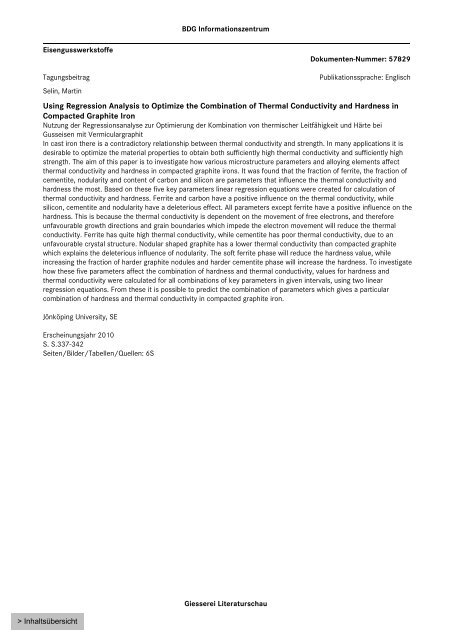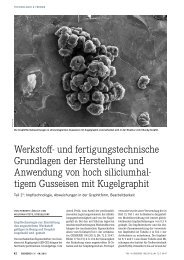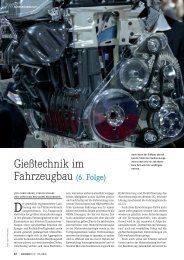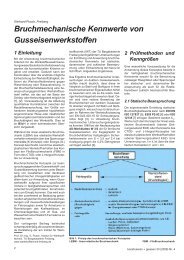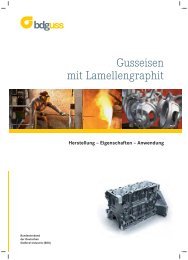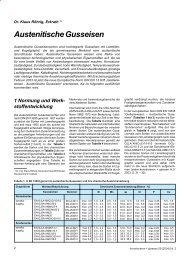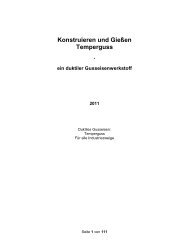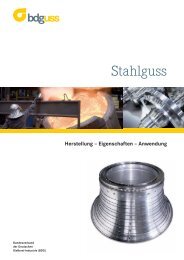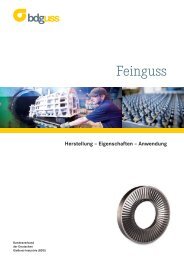Giesserei Literaturschau - Bundesverband der Deutschen Gießerei ...
Giesserei Literaturschau - Bundesverband der Deutschen Gießerei ...
Giesserei Literaturschau - Bundesverband der Deutschen Gießerei ...
Sie wollen auch ein ePaper? Erhöhen Sie die Reichweite Ihrer Titel.
YUMPU macht aus Druck-PDFs automatisch weboptimierte ePaper, die Google liebt.
BDG Informationszentrum<br />
Eisengusswerkstoffe<br />
Dokumenten-Nummer: 57829<br />
Tagungsbeitrag<br />
Selin, Martin<br />
Publikationssprache: Englisch<br />
Using Regression Analysis to Optimize the Combination of Thermal Conductivity and Hardness in<br />
Compacted Graphite Iron<br />
Nutzung <strong>der</strong> Regressionsanalyse zur Optimierung <strong>der</strong> Kombination von thermischer Leitfähigkeit und Härte bei<br />
Gusseisen mit Vermiculargraphit<br />
In cast iron there is a contradictory relationship between thermal conductivity and strength. In many applications it is<br />
desirable to optimize the material properties to obtain both sufficiently high thermal conductivity and sufficiently high<br />
strength. The aim of this paper is to investigate how various microstructure parameters and alloying elements affect<br />
thermal conductivity and hardness in compacted graphite irons. It was found that the fraction of ferrite, the fraction of<br />
cementite, nodularity and content of carbon and silicon are parameters that influence the thermal conductivity and<br />
hardness the most. Based on these five key parameters linear regression equations were created for calculation of<br />
thermal conductivity and hardness. Ferrite and carbon have a positive influence on the thermal conductivity, while<br />
silicon, cementite and nodularity have a deleterious effect. All parameters except ferrite have a positive influence on the<br />
hardness. This is because the thermal conductivity is dependent on the movement of free electrons, and therefore<br />
unfavourable growth directions and grain boundaries which impede the electron movement will reduce the thermal<br />
conductivity. Ferrite has quite high thermal conductivity, while cementite has poor thermal conductivity, due to an<br />
unfavourable crystal structure. Nodular shaped graphite has a lower thermal conductivity than compacted graphite<br />
which explains the deleterious influence of nodularity. The soft ferrite phase will reduce the hardness value, while<br />
increasing the fraction of har<strong>der</strong> graphite nodules and har<strong>der</strong> cementite phase will increase the hardness. To investigate<br />
how these five parameters affect the combination of hardness and thermal conductivity, values for hardness and<br />
thermal conductivity were calculated for all combinations of key parameters in given intervals, using two linear<br />
regression equations. From these it is possible to predict the combination of parameters which gives a particular<br />
combination of hardness and thermal conductivity in compacted graphite iron.<br />
Jönköping University, SE<br />
Erscheinungsjahr 2010<br />
S. S.337-342<br />
Seiten/Bil<strong>der</strong>/Tabellen/Quellen: 6S<br />
<strong>Giesserei</strong> <strong>Literaturschau</strong>


